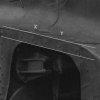Most if not all the S7 loco's I've built have had 29mm o/a frames. This seems to be an acceptable dimension to most, it does give some side play clearance for those running on tighter curves etc. and bogie wheel clearances can be a problem which this helps with , so I reckon 28.5 - 30.oomm for o/a S7 frames is ok.

Col.
Colin, that does seem to confirm what I've heard whispered here and there.
Because the W1 has an etched outer overlay the width over plate work is only 27.50 mm, but over rivets is nearer 28.00 mm and it'll be those raised details that touch the wheel rims first and short it out.
For finescale 28.00 mm is quite wide, the Finney A4 has something like 25.85 mm over frames for finescale (measured spacers off the etch without cusp removal) and 27.95 mm for S7. Both quite narrow in my view.
I did drop in some S7 wheels at the rear end as a comparison.

Tolerances have got tighter over the years so you could use the A4 S7 spacers for a finescale model if you wanted close tolerances, clearly the days of 26.00 mm for finescale receeding.
So, the question is, are a set of frames set to 28.00 mm acceptable for both gauges ? For me personally it's not, I much prefer as near to 30.00 mm as possible and yes it does limit the curvature. However given the additional cost (below) it would take to add S7 stretchers, I think I'd live with it.
Going back to the Finney A4, there are only three or four spacers I think, not a lot of art work or space taken up offering both for users, on the W1 the stretchers and stays take up nearly 40% of an A3 sheet of etch, so that brings another question, do you offer both sets in one package, bearing in mind that for every single model, 40% of the chassis etch is waste, and that 40% adds 40% to the material costs.
Should those modeling (assuming for theory purposes that this is a commercial commodity) finescale or S7 have to pay the extra 40% on the chassis for the waste they are never going to use, the parts are totally incompatible?
I'd say not, so, do you run with finescale only and cut off S7, or, offer S7 as well but as an extra...but then why should S7 modelers have to pay more for those parts, surely they are entitled to the same pricing as finescale modelers.
Trust me, the issue of S7 and/or finescale has vexed me for some considerable time, the problem is, the more complex we modelers make the frames...and I strongly believe this is the way forward.....the bigger this issue and resultant cost becomes. In the days of tube spacers and simple L or U spacers the issue was virtually zero, but when your talking nearly 50 individual parts that make up 40% of the metal work and 75% of the construction parts, then it's a different ball game.
Ironically, the rear end where the frames widen is true scale, thus giving me the maximum space for the rear bogie and Cartazzi truck to swing when using finescale wheels, the front end is a different matter and some cunning and limited side play will need to come into force to stop the rear bogie wheel touching the cylinder wrappers.
Either way, the W1 is not designed to be run on four foot curves laid on the carpet

there are plenty of models already out there for that. It should cope with 6 foot radius but I think 7 foot is more comfortable, even then, for an engine this big, 7 foot is realistically very tight. If it runs round something like Heyside then it'll achieve what we set out to achieve at the start of the project. The test chassis did run through Love Lane crossover with no problems so it should all work fine.
Mick D


















